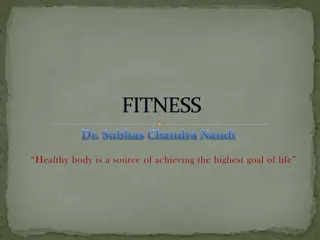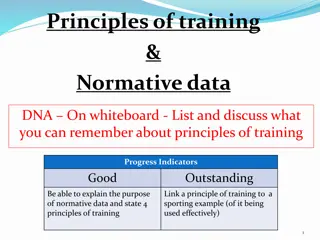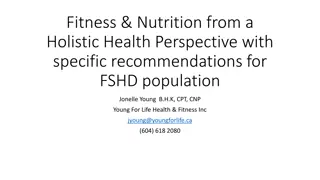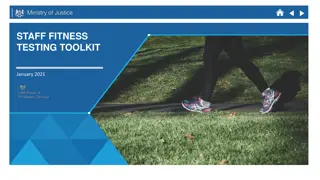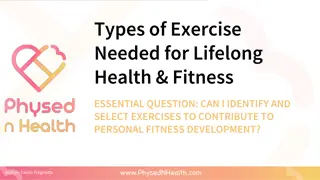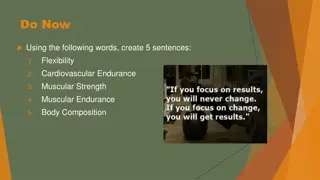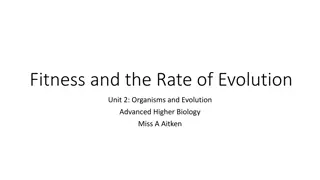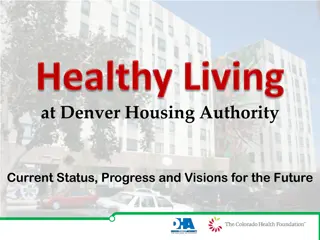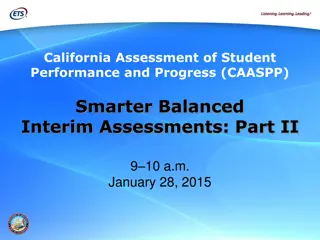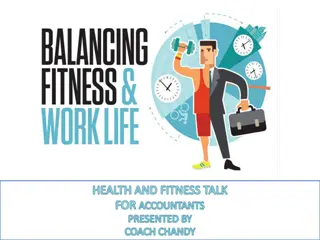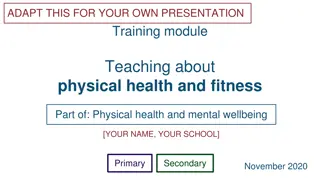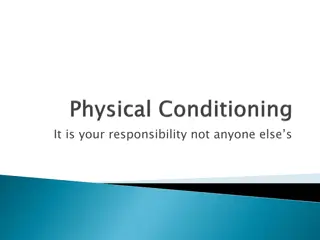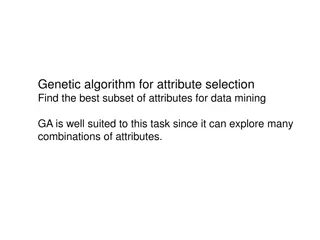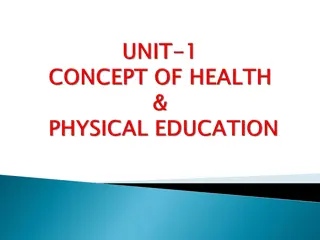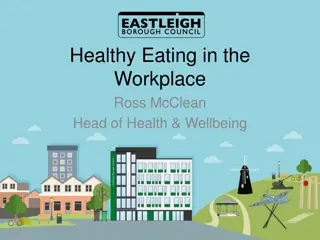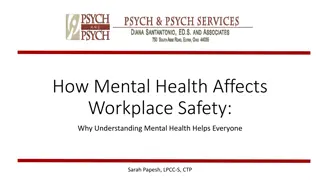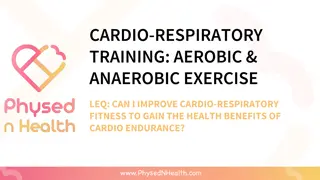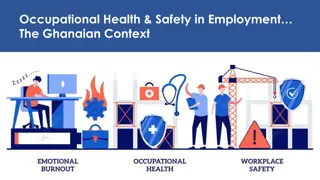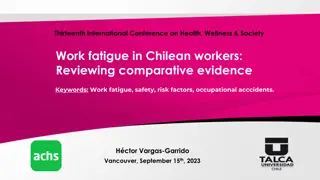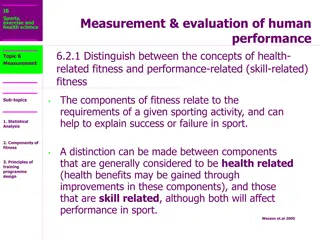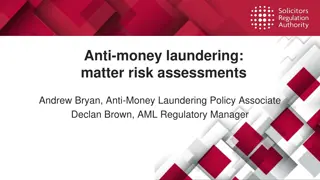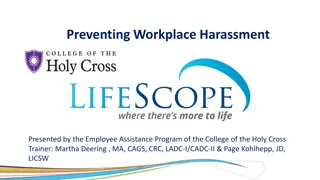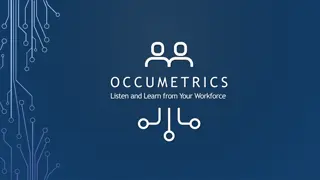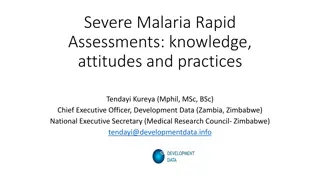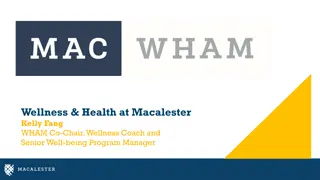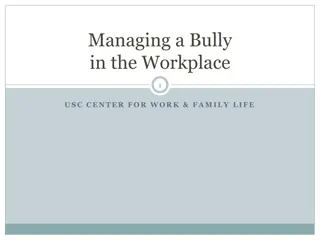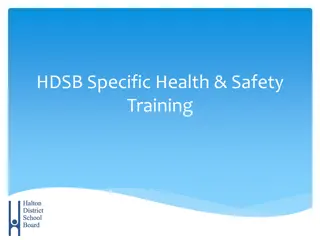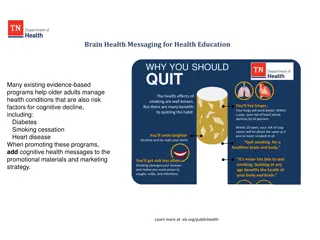Promoting Health and Well-being in the Workplace: A Guide to Fitness for Work Assessments
Understanding the importance of fitness for work assessments in promoting employee health and well-being. Discusses factors determining fitness for work, benefits of work, and helpful questions for job modifications to support employees in returning to work effectively.
Download Presentation

Please find below an Image/Link to download the presentation.
The content on the website is provided AS IS for your information and personal use only. It may not be sold, licensed, or shared on other websites without obtaining consent from the author. Download presentation by click this link. If you encounter any issues during the download, it is possible that the publisher has removed the file from their server.
E N D
Presentation Transcript
John Jewitt David Anderson 2016
Fit notes Physical demands of work falling since the 1950s and yet increase in sickness certification Most common reason for issuing notes is back pain and increasingly mental illness Drs- certified in the past so patients can obtain sick pay or benefits Therefore the fit note was developed
Making an assessment Assessment can be: Face-to-face consultation Telephone consultation Report from another Dr or health professional (eg discharge letter) Doctors should always consider the impact of their illness or injury on their capacity to work Fitness for work depends both on attributes of the patient and on the nature of the job
Factors determining fitness for work Nature and severity of health problem(s) Patient s attitudes and expectations Physical and mental demands of job - Such as a plumber who has knee arthritis. Potential for work to exacerbate illness - such as effect of boss/ bullying. Safety considerations - remember to consider travel to and from work
Health benefits of working Department for work and pensions website: Evidence shows that work has therapeutic value and is generally good for physical and mental health and well-being whilst long term worklessness has negative health effects (Waddell G. and Burton A.K. 2006, Is work good for your health and well-being?)
Questions that may be helpful in identifying the need and scope for job modifications What is your job, and what tasks does it involve? Are there aspects of your job that you would find difficult or impossible because of your health problem(s)? If so, are there simple ways in which your job could be changed to overcome these difficulties? Is there another job that you would find easier, to which your employer might move you while you are recovering?
Examples of modifications that may help a patient to return to work Phased return to work The patient could restart with reduced working hours and build up gradually to normal levels. Working fewer hours each day is usually preferable to fewer days each week Altered hours Consider the time of work as well as the number of hours a day for example, a patient recovering from depression may find early starts especially difficult
Amended duties Changes in the organisation of work might help: an anxious patient with reduced confidence may benefit from working in a team rather than alone Changes in job content might help: a patient with back pain may need to avoid prolonged sitting to reduce discomfort Workplace adaptation Changes to seating or other aspects of a work station may be necessary to improve comfort in a patient with back pain
Attitudes Attitudes to work attendance vary widely. Not all aspects of work are pleasant, and some people may enjoy a legitimised opportunity for absence, at least in the short term and vice versa. Doctors should not collude in what they have good reason to believe is malingering. However, they should make due allowance for differences in patients attitudes
Homework: reading See Department of Work and Pensions website (DWP): https://www.gov.uk/government/uploads/system/uploa ds/attachment_data/file/183249/fitnote-gps- guidance.pdf
FIT NOTES QUIZ 1. Can I back-date a fit note? 2. Can I issue a fit note with a future start date? 3. My patient has two jobs, should I issue two fit notes?
Fit note Quiz 4. Does the patient need to return to see the Dr at the end of the period covered by the sick note? 5. What if I am asked for a fit note saying someone is fit for work? 6. If a patient may be fit for work, what parts of the fit note do you need to complete?
Fit Notes Quiz 7. How do you record the time period for which your advice applies: either about being unfit for work, or that the patient may be fit for work? 8. How long can you issue a fit note for? 9. Can a patient return to work before the fit note expires?
Anxious patient Mrs A is a bank clerk who has been off for 4 weeks with low mood. She forgot that her sick note ran out that day and she is worried that her employer will be annoyed. You are on a busy Friday afternoon clinic and you do not know Mrs A. She has seen your colleague for the last 2 times in the past 6 weeks and he is not here today. He has recorded though that Mrs A may be fit to return to work at the end of this note. Mrs A has a long h/o anxiety and depression as well as several periods of sickness certification in the past 3 yrs.
video https://www.youtube.com/watch?v=14be0hjwhAw
Your Case Studies DO YOU HAVE ANY CASES THAT YOU CAN BRING TO THIS SESSION? A challenging case about fitness to work A situation where you were not sure whether to issue a fit note We can discuss these cases and all learn from them.
Case studies - one A delivery driver who can t drive Chris is a delivery driver for a major logistics firm. He has just had laser eye surgery and his post-op instructions include advice that he should not to drive for two weeks. He comes to see you expecting to be signed off from work.
Case studies - two Someone who is out of work John is out of work and visits you with a recent exacerbation of multiple sclerosis (MS). His records indicate that his MS occasionally relapses, with periods of good health in between. He is keen to find a job and asks about work during the consultation. He seems despondent about his recent flare-up as he thinks it means he won t be able to find a new job until he is better.
Case studies - three An employer can t make changes Alice works for a supermarket and visits you complaining of panic attacks. You diagnose anxiety disorder and refer her to a local talking therapy service. When you raise the issue of work, Alice says she is too distressed to work. She thinks that her job is causing her panic attacks and does not see how she can go back.
Case studies - four Relationship issues at work Timi comes to see you, complaining that she does not get on with her manager, she is feeling very stressed and asks to be signed off work.
Questions to ask when doing a fit note What is your job and what tasks does it involve? Are there any aspects of your job that you would find difficult or impossible because of your health problem? If so, are there simple ways in which your job could be changed to overcome these difficulties? Is there another job that you would find easier, to which your employer might move you while you are recovering?
Case studies - five Sandra, a 46 year old lady has recently been diagnosed with depression and started antidepressants 3 weeks ago. She has had 5 days off work and now comes to see you for a sick note. She works in payroll at the head office for a local distribution firm. She doesn t want anyone at work to know about her illness and doesn t want you to write it on the sick note. Hew new manager is very strict on sickness absence and she is worried about disciplinary action if she has too much time off. How would you approach this? Shall we try a role play?
Cas3 studies - six 46 year Mike presents requesting a new sick note for his chronic back pain. He s been off for the last 2 years. You notice a letter in his records from the DWP stating that he has been found fit for work following the work capability assessment. He doesn t mention that he s been examined. How do you proceed? Can you issue the note? Shall we try a role play?
JSA, ESA, IS, SSP, DLA, AA, CA and other abbreviations! They ve stopped me money Doc... John Jewitt David Anderson 2016
JSA You can claim JSA online if you are: actively looking for work or working fewer than 16 hours per week over 18 but below State Pension age living in England, Scotland or Wales need to attend an interview at the Jobcentre The new jobseeker interview
JSA payments Weekly amounts 18-24 up to 57.90 25 or over up to 73.10 Couples (both over 18) up to 114.85 Paid usually every 2 weeks
Employment and Support Allowance (ESA) Employment and Support Allowance provides financial help to people who are unable to work because of illness or disability. Open to employed, self-employed and unemployed. personalised support so that you can work if you are able to. It gives access to a specially trained personal adviser and a wide range of further services including employment, training and condition management support.
What you get (ESA) Assessment rate (same as JSA) for 13 weeks after claim. 102.15 / week if in work related activity group 109. 30 / week if in the support group Placement in above depends on the WCA (work capability assessment) Possible enhance disability premium at 15.75 / week Severe disability premium at 61.85 / week
Income support Income Support is extra money to help people on a low income. It s for people who don't have to sign on as unemployed. Whether you qualify or not and how much you get depends on your circumstances You need to be carer/ child under 5/ pregnant. Have savings below 16k Personal allowance and extra payments. Such as child benefit rate ( 20.70 and 13.70)
Statutory Sick Pay (SSP) If you're working for an employer under a contract of service (even if you've only just started and you have done some work), you're entitled to Statutory Sick Pay (SSP) if the following apply: you're sick for at least four days in a row (including weekends and bank holidays and days that you do not normally work) you have average weekly earnings of at least 102 a week Average weekly earnings are worked out by using earnings in the eight weeks before sickness began. The standard weekly rate for SSP is 88.45 a week.
Scenario 1 44 year old man who was injured in a RTA 18 months ago. He had fractures to his right femur, right scapula and right forearm. He now walks with a limp and is unable to walk distances of more than 400 metres without severe discomfort. He previously worked as a postman but was made unemployed 6 months ago as he could no longer perform his job. He attends to ask for a follow on sick note. You notice a recent letter in his notes stating that he no longer requires sick notes and should be considered fit for work.
Scenario 1: group work What benefits is he entitled to? What is the name of the assessment that he has been through prior to the practice receiving the letter? Where might he receive support? Under what circumstances might you be able to write a fit note?
Scenario 2 Jill is 20. She comes to see you because she can t make ends meet. Her boyfriend has just left her, they used to share a flat with their 2 year old daughter. Her boyfriend was the bread winner and Jill is in full time education at the local university studying nursing. She is using her savings but only has 1000 left and fears she will have to give up hercourse.
Scenario 2: group work What benefit might Jill be entitled to and what do you know about it? Where might she be able to get some support? How much savings is Jill entitled to have before she would not be able to get this benefit? Would she be entitled to JSA or ESA in addition?
Scenario 3 Sally is a 40 year old who has been working in I.T. for the last 3 weeks. She was previously unemployed after completing a degree in computing 2 years ago. She s just been discharged from hospital after she had and emergency laparoscopic cholecystectomy 3 days ago. She left hospital without discharge information. She is requesting a fit note as she is worried that she will not be entitled to any money and has bills to pay. You don t feel that she is fit to work.
Scenario 3: group work What are you going to do? What benefit might Sally be entitled to and what do you know about it? Who is responsible for paying the benefit?
Disability Living Allowance Disability Living Allowance (DLA) is a tax-free benefit for disabled children and adults to help with extra costs they may have because they re disabled.
DLA- who is entitled? You may get Disability Living Allowance if: you have a physical or mental disability, or both your disability is severe enough for you to need help caring for yourself or you have walking difficulties, or both you are under 65 when you claim You can get Disability Living Allowance whether or not you work. It isn't usually affected by any savings or income. Amount received is based on current needs and circumstances
DLA Disability Living Allowance has two parts called 'components': a care component - if you need help looking after yourself or supervision to keep safe a mobility component - if you can't walk or need help getting around Some people will be entitled to get just one component; others may get both. Paid at different rates depending on how your disability affects you.
DLA payments Care component Lowest = 21.80 help for some of the day/ meals etc Middle = 55.10 freq help or constant supervision Highest = 83.20 supervision/ help day and night. Mobility component Lower = 21.80 needs guidance / supervision outdoors Higher = 57.45 other, more severe, walking difficulty
DLA DS1500 Special rules - if you're terminally ill If you have a progressive disease and are not expected to live for more than another six months there are special rules. Get benefit more quickly and easily. Highest care component = 82.30 weekly
Proposed changes to Disability Living Allowance (DLA) The government wants to replace DLA with Personal Independence Payment to support disabled people with the greatest needs and help them live more independently. What the change means Between 2013 and 2016 everyone aged 16 to 64 receiving DLA will be reassessed to see whether they are entitled to the new Personal Independence Payment. People entitled to Personal Independence Payment will have their claims transferred over and their DLA will stop. Those not found to be entitled to Personal Independence Payment will be informed and their DLA will stop. They may be able to claim other benefits.
Personal Independence Payment Disability Living Allowance (DLA) has been fully replaced by Personal Independence Payment (PIP) for people aged 16 to 64 from 10 June 2013 for new claims only.
Personal Independence Payment What is PIP? PIP is to help towards some of the extra costs arising from a health condition or disability. It is based on how a person s condition affects them, not the condition they have. Can get from 21.80 - 139.75 a week depending on how the condition affects you, not the condition itself.
Personal Independence Payment Who is eligible? PIP is for people aged 16 to 64 DLA remains for children up to the age of 16.From October 2013, the Department forWork and Pensions (DWP) will contact them as they approach 16 to explain what will happen DLA remains available to existing claimants who were aged 65 or over on 8 April 2013 (the day that PIP was introduced).
Key facts I In the same way as DLA, claimants can receive PIP whether they are in or out of work. The benefit is not means tested or taxed. There are two components to PIP: for daily living - and mobility needs. Each component can be paid at standard rate, or enhanced rate for those with the greatest needs. May require a face-to-face assessment as part of claim.
Key facts II Subject to regular review. Payment calculated through a points system for each component: Daily Living Mobility Between Oct 2013-2015, all current claimants of DLA between ages of 16-64 will be re-assessed. Further reading: http://www.dwp.gov.uk/publications/specialist- guides/pip-toolkit/


